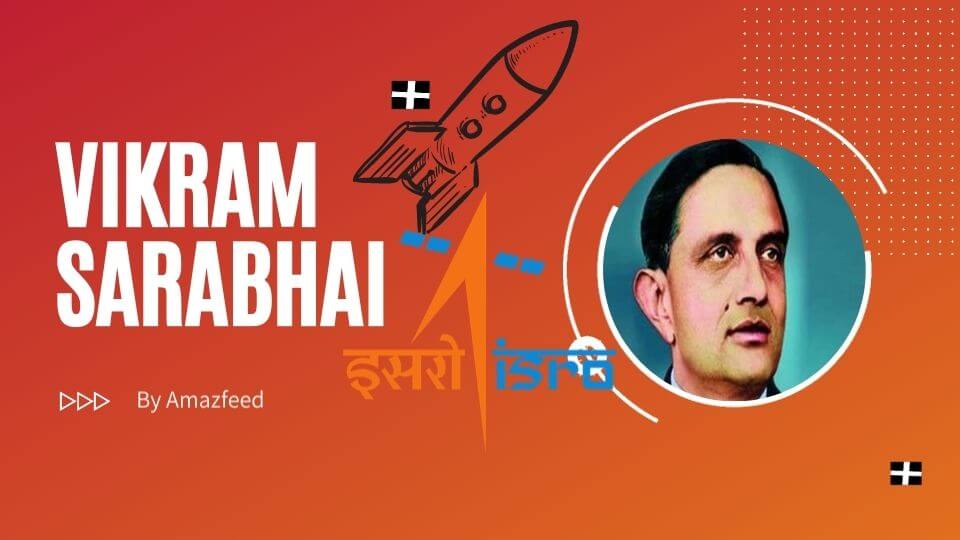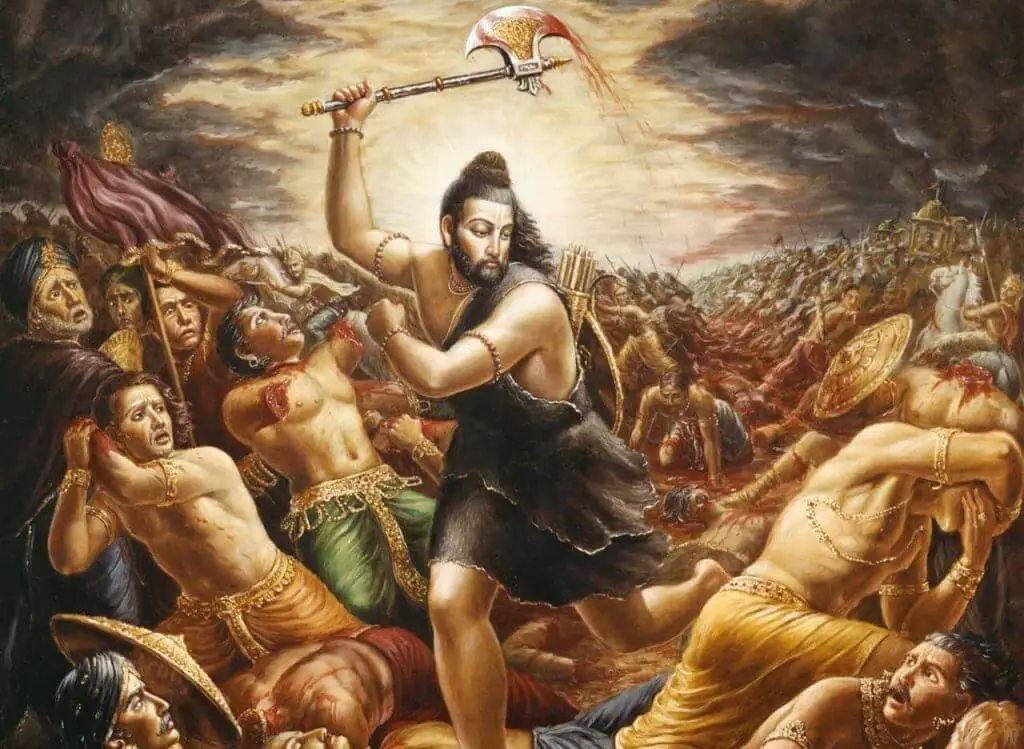“Failure is not about succeeding. Rather it is about not putting your best effort and not contributing, however modestly, to the common good.”
– Vikram Sarabhai
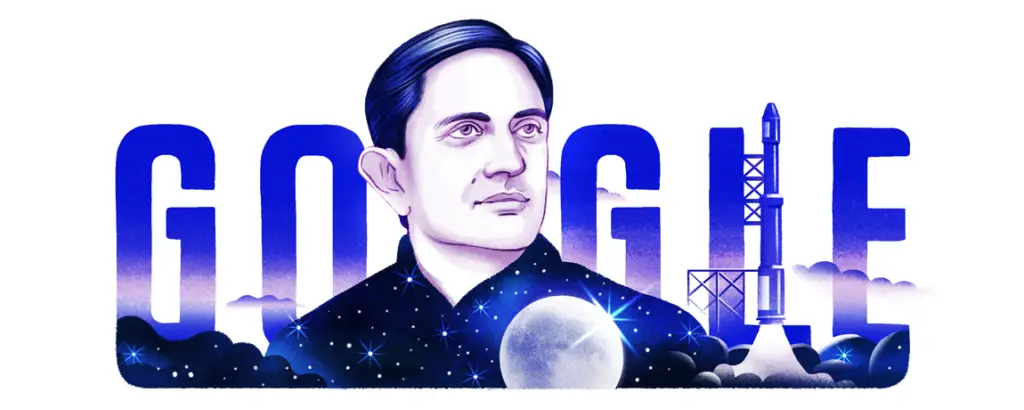
This year on 12th august India celebrated the 101st birthday of the father of the Indian space program Vikram Sarabhai. On his 100th birthday last year, Google celebrated his birthday with the Google doodle. A blue and white starlit portrait of him with the Google font written in the same blue colour, a rocket, and a moon shining on the edge summed up his achievements in space science.
The founding father of the Indian space research system Dr. Vikram Sarabhai was a rare combination of a scientist, innovator, industrialist, visionary, and an award-winning physicist. It was dr. Sarabhai started a project for the fabrication and launch of India’s first satellite the Aryabhata.
But unfortunately, he did not live to see its launch in 1975, which happened four years after his death. For his immense contribution to the field of science and innovation, he was awarded the Padma Bhusan in 1966 and conferred the Padma Vibhushan posthumously in 1972.
Coincidentally Dr. Srabhai’s centenary comes just weeks after the launch of India’s second lunar mission Chandrayaan – 2. The Lander of Chandrayaan 2 has been named Vikram to honour the late Dr. Sarabhai. Let’s look back at the unparalleled and unforgettable contributions of Dr. Vikram Sarabhai to Indian space science. His influence on young scientists and how he guided them to take India’s space mission to greater heights even after he was gone.
Early life and education
Born on 12th august in 1919 in Ahmadabad, he was the eight children of Ambalal and Sarla Devi. His family was very affluent, which managed several textile mills. After passing the intermediate science examination from Gujarat College in Ahmadabad, he went to England for his further studies.
He got his doctoral thesis at Cambridge University, and it was on ‘cosmic ray investigation in tropical latitudes.’ After coming back to India, he joined the Indian Institute of Science in Bangalore to research cosmic rays. This was something he undertook on the advice of the eminent scientist and Nobel laureate Dr. C V Raman. He returned to Cambridge in 145 to further his research on cosmic rays and his Ph.D. for his thesis on his ‘cosmic ray investigation in tropical latitudes.’
Establishing PRL
He returned to India when the country had newly become independent, sensing the need for battles scientific facilities in the country Sarabhai convinced the charitable trust his family managed to establish the physical research laboratory or PRL in Ahmadabad in November 1947.
He was the founding director of the Indian Institute of Management (IIM), which was the second IIM in the country. Along with businessman Kasturbhai Lalbhai, he played a key role in setting up the institute of learning in 1961.
India’s first step towards space – INCOSPAR
After Russia launched the sputnik satellite, Sarabhai started convincing the Indian government that that country should focus on space research. After continuous persuasion the Indian government saying that to play a meaningful role nationally and in the community of nations we must be second to none in the application of advanced technologies to the real problems of man and society.
However, the Indian government agreed to set up the Indian national committee for space research (INCOSPAR) in 1962, during Jawaharlal Nehru’s tenure. Sarabhai was the first chairman of the committee. This organization was later renamed as Indian space research organization (ISRO) in 1969. He took over an advisory role in ISRO as well.
The astonishing story of India’s first rocket launch
He is a staunch believer in using science and technology as a means of development. He is today a member as the father of the Indian space program because of his immense contribution to this field. One such contribution is India’s first rocket launch.
Years ago, on November 21, 1963, on the outskirts of Thiruvananthapuram, from a small village Thumba, announcing the birth of the modern space age in India. The sleepy palm-fringed village soon become popular as Thumba Equatorial rocket launch station (TERLS). Later it became Vikram Sarabhai Space Centre (VSSC).
Till 1963, Thumba most probably never thought of becoming a rocket launching station. It was a quiet village in Kerala, a fishing hamlet with coconut trees, a peaceful sea, and thatched huts until t caught the attention of Dr. Vikram Sarbhai. There is a small church dedicated to St Mary Magdalene, which coincidentally located on the earth’s magnetic equator.
The magnetic equator is an imaginary line on earth surrounding the planet connecting all the points on earth, where a magnetic needle, if suspended freely, will remain horizontal. It is a crucial line, a very important one, especially for a space mission. Here the equatorial Electrojet exists – a stream of electrons whizzing across the sky, about 110-120 km above the earth’s surface. Such electrons are vital for studies in the field of physics, astronomy, and meteorology.
1.Vikram Sarabhai didn’t choose this place out of the blues. Thumba is located at 8o32’34” N and 76o51’32” E, a low-altitude, upper atmosphere, and ionosphere studies. Before the full-blown spaces project in Thumba, these were the baby steps towards India’s first rocket launching program.
One fine morning Dr. Sarabhai and his fellow scientist Dr. APJ Abdul Kalam went to the church to talk to the bishop, Reverend Peter Bernard Pereira, who lived in the adjacent house to the church. They wanted the church as well as the land adjacent to it and to set up their workshop. Instead of giving them a decision, he asked them to join the Sunday mass where he will propose the offer to the parishioners.
On Sunday bishop explained the idea to the mass, and with his efforts, their permission was granted. Within only 100 days they filed all the paper works, the villagers happily relocated to a new place with a new church. Soon the church turns into a full-blown workshop, the bishop’s house an office, cattle sheds as storage houses and laboratories. With a scanty amount of funding, they started to create history.
Some enthusiastic young scientists began to assemble their first rocket. But they were not just any scientist they were handpicked by Dr. Vikram Sarabhai. But other than that all of them also got training at NASA’s Wallops Island launching facility in Virginia, United States. Among them, there was the former president and the great scientist of India Dr. APJ Abdul Kalam, and veteran scientist R Aravamudan.
“One wants permissive individuals who do not have a compelling need to reassure themselves that they are leaders.”
In the initial day’s Thumba had no facilities such as a canteen or transportation. The scientists would reach there by cycle and for breakfast and dinner, they had to come back to Trivandrum (got their lunch packed). The only jeep they had was always busy, so they had to either ride their cycles or walk.
Even it is so fascinating that they even transported the rocket parts on the cycle or bullock-carts. It was in these tough settings that India made it to their first rocket launch – that of a Nike-Apache rocket supplied by NASA.
After six months of hard labor, on November 21 1963, India was ready for its very first rocket launch. Many legendary scientists and eminent bodies of technology gathered for this occasion comprising Dr. Homi Bhabha (the father of the Indian nuclear program), and Dr. P R Pirashoty (the founder-director of the Indian Institute of tropical meteorology). The ruling bodies of Kerala like the governor and district collector were present there with the bishop too.
As he said, “He who can listen to music in the midst of noise can achieve great things.” He did achieve such a great thing – the successful launch of India’s first rocket. The sultry air of Thumba was thick with tension when the rocket was about to whoos out of the launchpad. While the process of the launch just began, the hydraulic crane developed a leak. However, they manually fixed it and put it back in place, but then the remote system of the launcher started to show malfunctions.
Once they fixed it, everyone’s forehead became a little less frowned. As India was about to set history and launch its first-ever rocket the scientists along with Dr. Vikram Sarabhai, hold their breath. They put their sweat and blood into this project. At 6.25 pm world watched India put its first signature on space with the sodium vapor clouding up in the orange-tinted sky by the setting sun.
Sarabhai was probably on cloud nine. Excited he sent a telegram to his home – “Gee whiz wonderful rocket show.” He congratulated every person on the team who made history and Indians proud. He also talked about his dreams of having India’s very own launch vehicle.
Over the years, ISRO not only fulfilled his dreams but also took Indian space achievement to such heights that would make envy the world with its success on a shoestring.
Today Thumba is the hub of all Indian space programs in collaboration with ISRO. They have given India the launch vehicles, geo satellites, and some of the outstanding remote sensing satellites.
His contribution to establishing several institutions
Sarabhai set up several institutions of national importance, including the centre for environmental planning and technology. He also served as the chairman of India’s atomic energy commission between 1956 – 1971. Sarabhai established a permanent recording station at Ahmadabad, and subsequently two more at Kodaikanal (1951), and Trivandrum (1955). His commitment to science education in the country also led to the community science center and is set up in Ahmadabad. Today the institution bears his name.
Sarabhai’s contribution to the wholesome development of India: “I have often claimed that I have had one good idea in life: that true development is the development of women and men.” – Dr. Vikram Sarabhai.
His vision and mission were not only to mark India’s name on the history of space science but he wanted to implement all this into the social and economical development of India. He always said we will use space to solve India’s issues. We are a tropical country ravaged by cyclones every year so we need a weather satellite. We are a very huge we cannot use traditional modes of communication for connecting people, so can we use satellite technology to connect people. That is how today we get to use mobile and television or any other mode of communication.
From a Russian cosmodrome
Sarbhai was the person who started working on rocket design. If you look at India’s space program it is very unique. We started with satellites first. We neither had any rocket to launch them nor knew how to use them. But anyhow he decided to build a satellite first.
- India’s first satellite – Aryabhata
Sarabhai started a project for the fabrication and launch of an Indian satellite. As a result, India put its first artificial satellite Aryabhata, named after the legendary Indian mathematician Aryabhatta, in orbit on April 19 1975 from Kapustin Yar.
- Bringing cable television to India:
Vikram Sarabhai was also responsible for bringing cable television to India. His constant contact with NASA paved a way for the establishment of a satellite instructional television experiment (SITE) in 1975.
- setting up CEPT University
He was the driving force behind the setting up of the center for environmental planning and technology university (CEPT) in Ahmadabad in 1962
- founder of Neheru foundation of development
in 1965, he founded the Neheru foundation for development (NFD), which is dedicated towards the promotion of the basic study of the current issues of societal and individual development.
- Establishing VASCSC
During the 1960’s he also established the Vikram A Sarabhai community science center for promoting science and mathematics education among students and the general public. The organization aimed at stimulating interest in science subjects among the masses.
- India’s first market research organization
He was more than just a scientist he set up India’s first market research organization, the operation research group that aimed to apply modern analytical research to meet the needs of clients. This was one of the earliest efforts of India to apply analytics to a business environment.
- IIM, Ahmedabad
He set up the Indian Institute of Management in Ahmadabad after realizing the need for an institute of management.
Dr. Homi Bhabha fully supported Sarabhai in his venture, who was a pioneer in the field of nuclear research in India.
Marriage and personal life
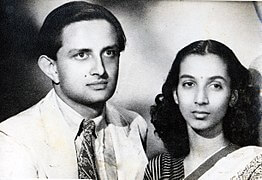
Dr. Vikram Sarabhai married world-renowned classical dancer Mrinalini Sarabhai in 1942. They had two children. His daughter Mallika gained prominence as an actress and activist, and his son Kartikeya also become an active person in science. Marrying Mrinalini Devi piqued his interest in performing art, and the two co-founded the Darpana Academy of performing arts in Ahmadabad.
Dr. Sarabhai passed away suddenly at the age of 52 on December 30 1971. He dies in a hotel room in Kerala soon after witnessing the launch of a Russian rocket and laying the foundation stone of Thumba railway station.
The first death anniversary of the father of India’s space program, they commemorated with the Indian postal service releasing a stamp in his name.
Dr. Sarabhai is also one of the few lucky ones to have a crater on the moon named after them. In 1974 a moon crater was named Sarabhai crater by the international astronomical union in Sydney, Australia. It is a small circular crater with an 8 km diameter located on the north-east part of the moon in the sea of tranquillity.
His relationship with Dr. Kalam
Other than his great achievements that become a gift for the nation, he also gifted the nation a gem. A young aspiring scientist who caught the attention of Dr. Sarabhai, and in no time he was selected in the team of the Thumba rocket launch project. He is the one and only Dr. A P J Abdul Kalam – the missile man and the former president of India.

Vikram Sarabhai played a chief role in mentoring Dr. A P J Abdul Kalam in the initial stages of his career. Impressed by his educational achievements and humble background it was Dr. Sarabhai who selected and sent young Dr. Kalam to NASA as a part of a seven-member team to work with the American space agency. To learn the art of assembling and launching small rockets for collecting scientific data.
Later, Kalam also worked directly under Vikram Sarabhai as a project director of the Rohini satellite program. Known for trying novel ideas and roping in young people Dr. Sarabhai was believed to have a lot of faith in the capabilities of youth and Novus. This is what led him to nurture and guide a young kalam in his early years as a scientist.
Dr. Kalam once said about his mentor as I quote, “I have seen political leaders sub political leaders in India they can spot people. I was spotted by Professor Vikram Sarabhai, because i was not highly qualified. But I was working hard. I was acquiring the knowledge at that time when he spotted me as a young scientist.
Then he gave me the full responsibility to grow. Not only selected me when I was in the lower bottom but gave me a responsibility to grow, and he ensured that I succeed. If I fail, he was by my side. The greatest quality of a leader whether political, scientist or technology or our industry, when the success comes to the industry or the leader gives the success to stick, when the Failure comes, the leader absorbs the Failure. This is the greatest quality in politics.
This I witness actually in my life. When I failed in SLV-3 that is the first launch of SLV-3 putting the satellite in orbit it went to the Bay of Bengal. On that day he did a press conference, a national, international press conference there he avenged that we failed today, but in the near future, we will succeed. I am the project director, I am the mission director, but he took the responsibility of Failure. He was the chairman of ISRO. The next time I succeeded, he asked me to go and conduct a press conference. That means when success comes, he gives it to his people, when the Failure comes the leader absorbs.”
ISRO’s tribute to Sarabhai on his cemetery year
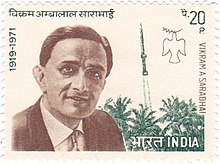
The current chairman of ISRO Dr. K Sivan paid tribute to Dr. Sarabhai announcing an award in his name – ‘Vikram Sarabhai journalism award in space science, technology and research.’ The award is to recognize outstanding contributions in journalism in the field of space science, applications, and research.
His words paying homage to dr. Vikram Sarabhai – “I am glad that ISRO along with other institutions are standing together in paying homage to this true son of India. I feel extremely privileged to be part of the generation who saw the transformational seeds sown by Dr. Sarabhai grow into plant and then into a blooming. The best tribute to Dr. Sarabhai is to work for his mission of transforming Indian to a country of it’s our future generations could be proud of.”
India’s second moon mission Chandrayaan 2 launched just a few weeks ahead of the cemetery birth anniversary of Dr. Vikram Sarabhai and it is paying a fitting tribute to the father of India’s space program, carrying onboard a lunar lander called Vikram, a first of its kind moulded for India that is said to make the country a pioneer in studying the moon on exploring the South Pole.
Awards and honours conferred
- Padma Bhushan (1966)
- Padma Vibhushan, posthumous (1972)
- Shanti Swarup Bhatnagar Award (1962)
- President of the Physics section, Indian Science Congress (1962)
- President of the General Conference of the I.A.E.A., Vienna (1970)
- Vice-President, Fourth U.N. Conference on ‘Peaceful uses of Atomic Energy’ (1971)
- A crater on the moon ‘BESSEL A’ has been named the Sarabhai crater by the International Astronomical Union in 1973.
- The Vikram Sarabhai Space Centre, (VSSC) which researches in the field of rocket propellants in Thiruvananthapuram is named after him.






